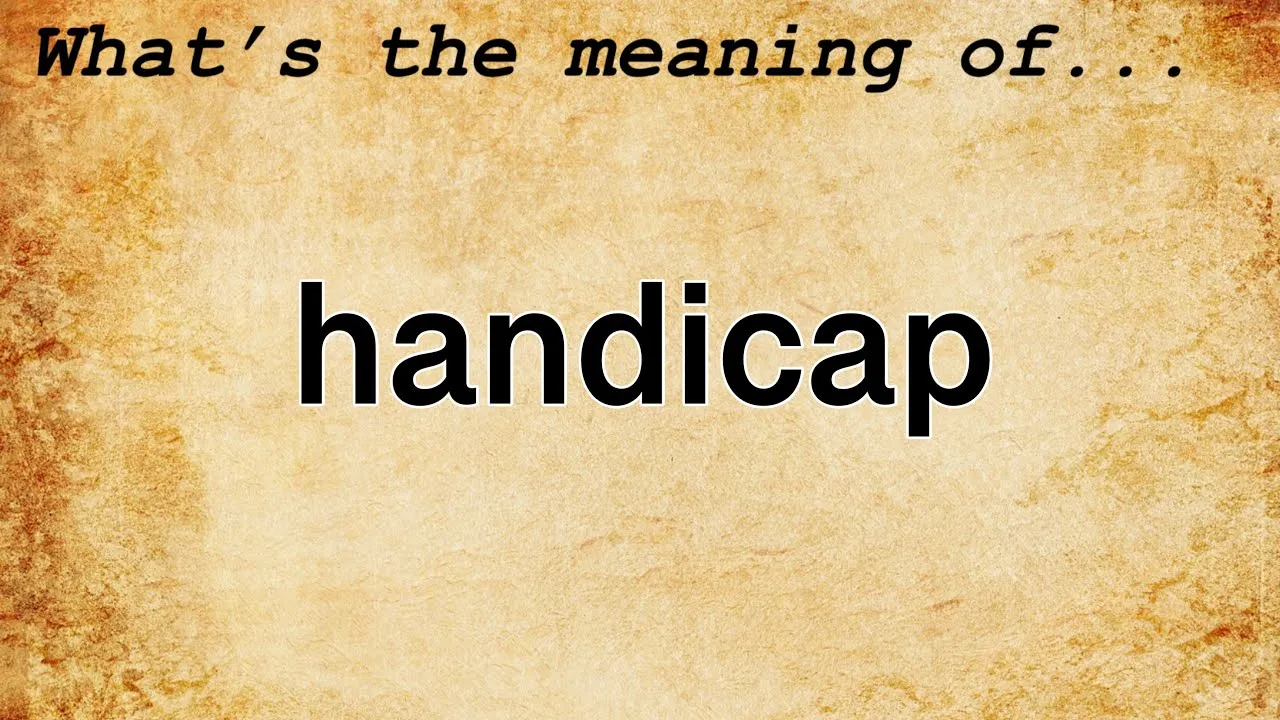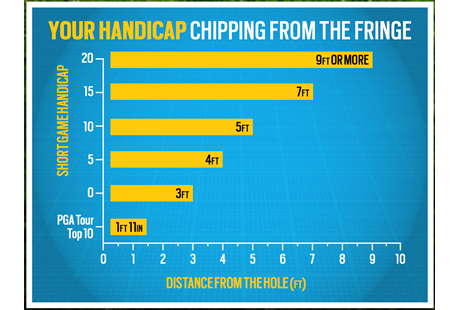As avid golfers, we all know that handicap plays a crucial role in our game. It allows us to compete with players of different skill levels and makes the game more fair and enjoyable. But if you’ve recently heard about the 2 3/4 handicap, you may be wondering what it means and how it affects your game. In this article, we will delve into the basics of the 2 3/4 handicap, its calculation, and how it differs from the standard handicap system.
The Definition of Handicap

Understanding the Concept of Handicap
In golf, a handicap is a numerical measure of a player’s potential ability. It represents the number of strokes above or below par that a player can be expected to shoot in a round of golf. Simply put, a handicap allows players of different skill levels to compete against each other on an equal playing field.
The basic principle behind a handicap system is that a golfer with a lower handicap is considered to be a better player than one with a higher handicap. Each hole on a golf course is assigned a difficulty level, known as the “slope rating.” A player’s handicap is then used to adjust their score based on the difficulty of the course. This ensures that every player has an equal chance of winning, regardless of their skill level.
Why it is Important in Golf
Handicap is a crucial aspect of the game of golf. It not only makes the game more inclusive and fair, but it also gives players the opportunity to track their progress and improvement over time. It allows players to compete against others of different skill levels and still have a chance of winning.
Furthermore, many golf tournaments and competitions require players to have a handicap within a certain range to participate. This helps to ensure that all players are on a relatively even playing field and that the results are not skewed by individual skill levels.
Types of Handicap Systems
There are several different types of handicap systems used in golf, with the most common being the standard handicap system and the USGA (United States Golf Association) system. However, there are also alternative systems such as the Slope Rating System and the 2 3/4 handicap.
Introduction to the 2 3/4 Handicap

What is the 2 3/4 Handicap?
The 2 3/4 handicap is a unique and simplified version of the standard handicap system. It was created in the 1970s by golf course designer Tom Fazio, who believed that the standard handicap system was too complicated for most amateur golfers. The name “2 3/4” refers to the maximum number of strokes a player can take on any one hole in order to maintain their handicap.
The 2 3/4 handicap is based on a golfer’s average score over their last 10 rounds of golf. Unlike the standard handicap system, it does not take into account the difficulty of the course or the slope rating. This makes it easier for beginners and casual golfers to calculate their handicap without having to worry about complicated formulas and adjustments.
History of the 2 3/4 Handicap
As mentioned earlier, the 2 3/4 handicap was created in the 1970s by Tom Fazio. He wanted to simplify the standard handicap system and make it more accessible to amateur golfers. Since then, the 2 3/4 handicap has gained popularity among recreational golfers, particularly in the United States.
Although it is not widely used in professional golf, some amateur tournaments have adopted the 2 3/4 handicap as their official handicap system. This is due to its simple calculation and ease of use for players of all skill levels.
How Does it Differ from the Standard Handicap System?
The main difference between the 2 3/4 handicap and the standard handicap system is the method of calculation. While the standard handicap system takes into account the difficulty of the course and adjusts a player’s handicap accordingly, the 2 3/4 handicap is based solely on the average of a player’s last 10 rounds.
This means that a player with a 2 3/4 handicap will have the same handicap regardless of the course they are playing on. This can be seen as an advantage for those who struggle with calculating their handicap using the standard system, as it eliminates the need for slope ratings and course difficulty adjustments.
Calculation of the 2 3/4 Handicap

Step-by-Step Guide on Calculating the 2 3/4 Handicap
Calculating your 2 3/4 handicap is relatively simple and only requires a few steps. Here’s how you can do it:
Step 1: Keep track of your last 10 rounds of golf
To calculate your 2 3/4 handicap, you will need to have recorded your scores from your last 10 rounds of golf. These can be from any course and can be played at any time.
Step 2: Calculate your average score
Add up the total number of strokes from your last 10 rounds and divide it by 10. This will give you your average score.
Step 3: Round to the nearest whole number
The 2 3/4 handicap is always a whole number, so if your average score has a decimal point, round it to the nearest whole number.
Step 4: Subtract 2 from your average score
Once you have your rounded average score, subtract 2 from it. This will be your 2 3/4 handicap.
For example, if your average score is 87, your 2 3/4 handicap would be 85 (87-2=85).
Examples of Calculating the 2 3/4 Handicap
Let’s take a look at a couple of examples to further understand how to calculate the 2 3/4 handicap.
Example 1:
Player A has recorded their last 10 rounds and has the following scores:
Round 1: 90
Round 2: 88
Round 3: 91
Round 4: 87
Round 5: 89
Round 6: 86
Round 7: 92
Round 8: 88
Round 9: 90
Round 10: 93
Step 1: Add up the scores and divide by 10
(90+88+91+87+89+86+92+88+90+93)/10 = 884/10 = 88.4
Step 2: Round to the nearest whole number
88.4 rounds up to 89
Step 3: Subtract 2 from the average score
89-2 = 87
Player A’s 2 3/4 handicap is 87.
Example 2:
Player B’s last 10 scores are as follows:
Round 1: 96
Round 2: 99
Round 3: 101
Round 4: 104
Round 5: 98
Round 6: 102
Round 7: 97
Round 8: 100
Round 9: 103
Round 10: 105
Step 1: Add up the scores and divide by 10
(96+99+101+104+98+102+97+100+103+105)/10 = 1005/10 = 100.5
Step 2: Round to the nearest whole number
100.5 rounds up to 101
Step 3: Subtract 2 from the average score
101-2 = 99
Player B’s 2 3/4 handicap is 99.
Tips for Improving Your 2 3/4 Handicap
As with any handicap system, the goal is to improve your score and lower your handicap. Here are some tips to help you improve your 2 3/4 handicap:
- Practice, practice, practice – The more you play, the more chances you have to improve your scores and lower your average.
- Work on your weaknesses – Identify the areas of your game that need improvement and focus on them during practice sessions.
- Learn course management – Knowing how to navigate a course and avoid potential hazards can significantly improve your score.
- Take lessons – A professional golf instructor can help you identify and correct any flaws in your swing or technique.
- Play with better golfers – Playing with players who have lower handicaps can challenge you to improve your game and learn from their strategies.
Pros and Cons of the 2 3/4 Handicap

Advantages of Using the 2 3/4 Handicap
- Easy calculation – As mentioned earlier, the 2 3/4 handicap is relatively simple to calculate compared to other handicap systems.
- No adjustment for course difficulty – You do not need to worry about slope ratings or adjusting your handicap for different courses.
- Suitable for beginner and casual golfers – The 2 3/4 handicap is perfect for those just starting in golf or those who only play occasionally.
Disadvantages of Using the 2 3/4 Handicap
- Not recognized by all tournaments – The 2 3/4 handicap is not as widely used as other handicap systems, so it may not be accepted in all competitions.
- Limited accuracy – Since the 2 3/4 handicap does not take into account the difficulty of the course, it may not accurately reflect a player’s skill level.
- Can be misleading – A player may have a low 2 3/4 handicap but struggle on more challenging courses, leading to unfair competition.
Comparing the 2 3/4 Handicap to Other Handicap Systems
While the 2 3/4 handicap has its advantages, it is essential to understand how it compares to other handicap systems. Here is a brief comparison of the 2 3/4 handicap to the standard handicap system and the USGA handicap system:
- The standard handicap system takes into account the difficulty of the course, while the 2 3/4 handicap does not.
- The USGA handicap system is more complex than both the standard and 2 3/4 handicap, but it is widely accepted in tournaments and competitions.
- Both the standard and USGA handicap systems are based on a player’s potential ability, while the 2 3/4 handicap is based on their average score.
Exploring Other Handicap Systems
Beside the 2 3/4 handicap, there are other handicap systems used in golf. Let’s take a quick look at two other popular systems:
Standard Handicap System
The standard handicap system is the most widely used method for calculating handicaps. It takes into account the slope rating of the course and adjusts a player’s handicap accordingly. This system is used in many tournaments and competitions around the world and is recognized by most golf associations.
USGA Handicap System
The United States Golf Association (USGA) handicap system is used primarily in North America and is similar to the standard handicap system. However, it also takes into account a “handicap differential,” which is a calculation based on a player’s score, the course rating, and the slope rating. This system is used in official USGA events and is widely accepted in amateur golf.
Slope Rating System
The Slope Rating System is a newer handicap system that was introduced in the late 20th century. It takes into account the difficulty of a course and measures the relative difficulty of a course for players of different skill levels. The higher the slope rating, the more challenging the course is deemed to be. This system is used in conjunction with the standard handicap system to determine a player’s handicap.
Conclusion
In conclusion, the 2 3/4 handicap is a simplified version of the standard handicap system that was created for amateur golfers. It is based on a player’s average score over their last 10 rounds and does not take into account the difficulty of the course. While it has its advantages, it is important to understand how it compares to other handicap systems and which one may be best suited for you. Regardless of which system you use, the most crucial aspect is to understand your handicap and use it to track your progress and improve your game. So go out there, enjoy your game of golf, and remember to always play fair and have fun!
